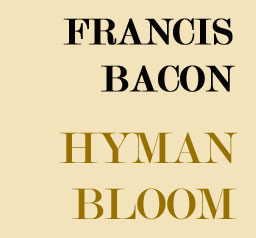The Bacon / Bloom Exhibition
by Robert Alimi, 2018

In 1953, Frederick Wight, Associate Director of Boston’s Institute of Contemporary Art (ICA), began working with Lloyd Goodrich, the Associate Director of the Whitney Museum of American Art, in planning a major Hyman Bloom retrospective which would open at the ICA in April, 1954. Wight wrote an insightful essay for the accompanying catalogue. The exhibition opened at the ICA and over the next 12 months traveled to the Albright, de Young and Whitney museums. Shortly after the plans were finalized for the Bloom retrospective, Wight left the ICA to take a position as director of the new Art Gallery at the University of California, Los Angeles. Over the next few years at UCLA, Wight organized shows for a variety of American and European artists including Hans Hofmann, Arthur Dove, Henri Matisse, and Pablo Picasso.
In 1960, Wight organized a two-man show of Francis Bacon and Hyman Bloom. The exhibition included 10 Bacon paintings, 7 Bloom paintings and 17 Bloom drawings; the show ran from October 30 until December 11, 1960. The majority of the Bloom oils came from the collection of George and Sally Kennedy. Kennedy had met both Bloom and Wight during his tenure as a geology professor at Harvard and had been a lender to Bloom’s 1954 retrospective. Kennedy, like Wight, left Massachusetts in 1953 to take a position at UCLA, in his case, to join the UCLA Institute of Geophysics and Planetary Physics.
In addition to sharing an overall focus on the human condition as subject, Bloom and Bacon had a bit more in common. The NY dealer Durlacher Bros. had Bloom solo shows in 1946 and 1948, and in late 1953 was preparing for another Bloom solo exhibition to take place in early 1954 while simultaneously presenting Bacon’s first solo show in the US. The Bacon exhibition at Durlacher Bros. opened in October 1953.
During the UCLA exhibition, MoMA curator Peter Selz gave a talk on the exhibition. In a 2017 conversation with me about the exhibition, the then 98 year old Selz reflected “Fred Wight had a very good idea to pair Hyman Bloom and Francis Bacon. It was a very good exhibition — Bacon and Bloom shared a common sense of despair for mankind.” As the exhibition reviews included below illustrate, the critics generally shared Selz’s opinions regarding the pairing of Bacon and Bloom.
